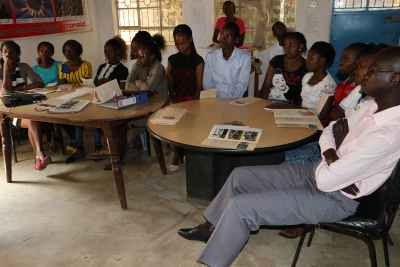Busia town is located at the international boundary between Kenya and Uganda, right at the Kenyan side of the border is Busia town which also serves as the headquarters of Busia County; one of the 47 2nd tier governments as per the Kenyan constitution of 2010[1]. The people of Busia in Kenya and Busia in Uganda are mostly from the Teso[2] ethnic group meaning that their share cultural attributes such as language, customs and traditions. Busia Kenya is also a business hub with many traders from other parts of Kenya residing or passing through the town on daily basis. In Busia town we met Mary Wasike[3], a member of the local Anglican Church. Mary has been involved in the business of recruiting young women who are looking for job opportunities in the Arabian Gulf. Mary often travels to the nearby Ugandan towns since she has relatives across the border, many times her networks in Nairobi place ‘orders’ for up to six girls at a time. For each girl that Mary connects with recruiters from Nairobi she gets paid KES. 15,000. At her house in Busia, Mary lives with her aging mother in a 2 bedroomed house, whenever she recruits these girls she brings them to her house in Busia town where they stay for atleast one week before her connection in Nairobi comes in a Toyota Noah to pick them up. The life of the girls once they arrive within Mary’s compund is usually restricted; they are not allowed to venture outside.

Members of ACTIVISTA a youth-led community based organisation in Kehancha town in Migori County during an information session on drivers of human trafficking among the Abakuria community in Migori County in Kenya in May 2019.
Mary’s connection in Nairobi is John Onyango[4], everytime he recieves a signal that Mary has recruited six girls then he travels to Busia from Nairobi, a distance of 400km in his Toyota Noah. For the six girls recruited, Mary earns KES. 90,000 and hands over the girls to John for onward transfer to Nairobi. On his way to Nairobi, John often carries extra money to bribe police officers who may stop him to ask for identification documents of the girls. On reaching Nairobi, John hosts the girls in his compund and facilitates them to acquire Kenyan identification documents then hands them over to a Mr. Ahmed who is not a registered recruitment agent for jobs in the Arabian Gulf. Mr. Ahmed then links them up with ‘jobs’ in Qatar, Oman and Saudi Arabia. In an interview with John and Mary they admitted that most of these girls end up working in brothels in the Arabian Gulf. They further admitted that many of these girls are often traumatised with their experiences in the Arabian Gulf. They further informed us that their network of traffickers is facilitated by local police who are aware of their trade but also seek ‘protection money’ from them.
The trafficking networks that exist along the Kenya-Uganda borders is driven by several factors: For the Ugandan girls that are recruited by Kenyan traffickers they are often promised jobs within Kenya and payment in Kenyan Shillings. The strength of the Kenyan Shilling versus the Ugandan Shilling attracts many Ugandan girls to a life of labour and sexual exploitation in Kenya. Further, the trafficking networks along the border, prey on girls from under-previleged households or even those from broken families, these are the ones most likely to be trafficked into Kenya and abroad. The normalisation of acts of human trafficking and general lack of awareness especially among rural communities is also a major contributor to the vice. In many parts of Kenya, village level traffickers earn commission by recruiting out of school youth who are mostly under the age of 18 to work for urban populations as house-helps, by moving these young girls to the cities and even abroad, they are exposed to a life of exploitation and servitude that robs them of dignity as many become victims of rape and sexual violence. The lack of awareness of the Counter Trafficking in Persons Act of 2010[5] which is the Kenyan law that deals with the crime of trafficking is also a major impediment to stemming the vice. In Busia County for example, the County Commissioner (the highest level civil servant) was the only one aware of the law. This means that in many cases, human traffickers are never prosecuted using the Counter Trafficking in Persons Act, rather, they are often released on bail on lesser charges using the Sexual Offences Act of 2006[6]. The lack of awareness within the Kenya Police Service and other prosecutory agencies there aids the activities of human traffickers in western Kenya.
[1] https://www.wipo.int/edocs/lexdocs/laws/en/ke/ke019en.pdf
[2] https://nalrc.indiana.edu/doc/brochures/teso.pdf
[3] Not her real name
[4] Not his real name
[5] http://kenyalaw.org/kl/fileadmin/pdfdownloads/Acts/Counter-TraffickinginPersonsAct_No8of2010.pdf
[6] https://www.ilo.org/wcmsp5/groups/public/---ed_protect/---protrav/---ilo_aids/documents/legaldocument/wcms_127528.pdf
Back to: Department of Politics